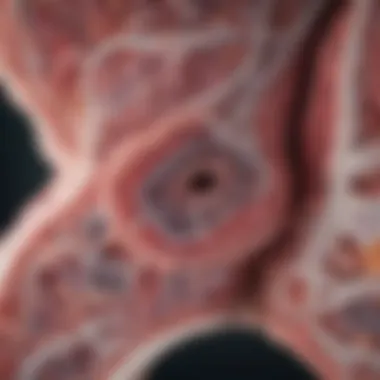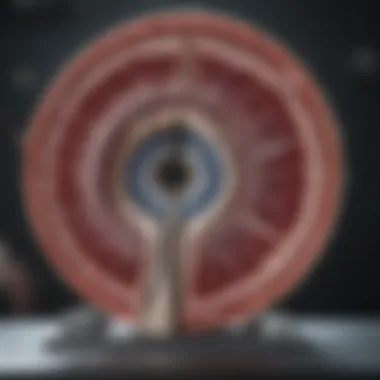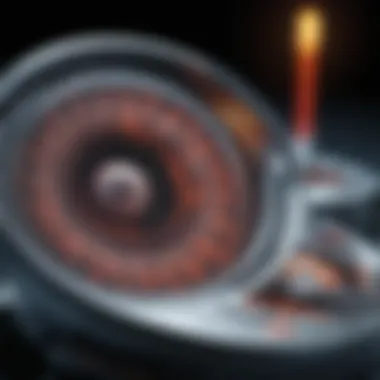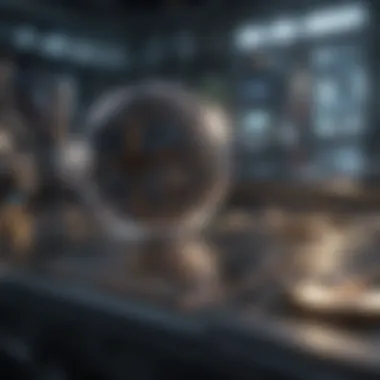Understanding HRCT: A Comprehensive Guide


Intro
High-Resolution Computed Tomography (HRCT) is an advanced imaging technology essential in modern medical diagnostics. This imaging method excels in providing intricate details of internal structures, allowing healthcare professionals to make informed decisions regarding patient care. The need for comprehensive imaging is paramount in varied medical fields, from oncology to pulmonology.
HRCT enables the examination of subtle changes in tissues and organs that traditional imaging techniques may overlook. Understanding the principles and applications of HRCT is vital for anyone involved in healthcare, whether they are students, educators, researchers, or practicing professionals. This guide aims to demystify HRCT, discuss its relevance in current medical contexts, and shed light on ongoing advancements in the field.
Key Concepts
Definition of the Main Idea
HRCT refers to a specialized form of computed tomography that focuses on increasing the resolution of the images produced. This technique uses thin slices of anatomical structures to generate detailed images that can reveal brief features of disease pathology. The precision of HRCT allows for better characterization of conditions, thereby enhancing diagnosis accuracy.
Overview of Scientific Principles
The functioning of HRCT relies on several scientific principles. Traditional CT scans acquire images using a fan-shaped x-ray beam. In contrast, HRCT generally employs a narrower x-ray beam and thinner slices. This enables better spatial resolution and contrast resolution.
Furthermore, HRCT images are often reconstructed using specific algorithms which enhance the depiction of structures within the body. This careful refinement and reconstruction provide valuable insights for clinicians, making HRCT a pivotal tool in diagnostics.
Current Research Trends
Recent Studies and Findings
Ongoing research continually builds on the effectiveness of HRCT. Recent studies have highlighted its invaluable role in identifying early signs of interstitial lung disease and various cancers. Improved detection rates contribute to better patient outcomes, as early intervention remains critical in many cases.
Significant Breakthroughs in the Field
There have been several breakthroughs in HRCT technology, including advancements in software capabilities and algorithm efficiency. These enhancements allow for real-time processing and improved image quality. Additionally, innovations in spectral imaging offer the potential for further differentiation of pathologies.
These advancements signify a move towards precision medicine, where diagnoses are sharper and treatment paths more personalized.
These advancements signify a move towards precision medicine, where diagnoses are sharper and treatment paths more personalized.
In summary, HRCT is not just a tool but a cornerstone in contemporary medical imaging, facilitating better patient management and outcomes through its detailed insights and ongoing evolution. Its relevance across medical fields must be recognized by all involved in healthcare.
Prologue to HRCT
High-Resolution Computed Tomography, or HRCT, serves as a crucial component in modern medical imaging. It enhances the ability to view minute structural details within the human body, particularly in the lungs and other critical organs. This section underscores the importance of HRCT and lays the foundational understanding necessary for the rest of the article.
HRCT is particularly beneficial in diagnosing various health conditions through its detailed imaging capabilities. It provides clearer images than standard computed tomography (CT) scans, thus revealing abnormalities that may not be visible otherwise. Moreover, HRCT plays a pivotal role in the respective fields of pulmonary medicine, oncology, and cardiology.
Additionally, it provides clinicians with vital information that often influences treatment decisions. Knowledge of HRCT is indispensable not just for healthcare professionals but also for students and researchers in the medical field.
In summary, the following sections will explore the definition of HRCT, its historical development, technical underpinnings, and the diverse clinical applications that underscore its significance today.
Defining HRCT
High-Resolution Computed Tomography is an advanced imaging technique that employs specialized protocols to produce high-quality, detailed images. Unlike traditional CT scans, which are designed for general diagnostic purposes, HRCT focuses on enhancing the contrast and resolution of images specifically in the lungs and thoracic structures. This technique often uses a thinner slice thickness, leading to sharper images that help in the identification of subtle radiological patterns, critical in diagnosing diseases such as interstitial lung disease or pulmonary fibrosis.
The operational principles involve advanced algorithms and calibrations that enhance the image quality while minimizing artifacts. Conventional CT scans may miss important details due to their lower resolution; however, HRCT can elucidate complex anatomical structures, thus providing clinicians with the information needed for accurate diagnosis.
Historical Development
The emergence of High-Resolution Computed Tomography can be traced back to its introduction as a specialized imaging modality in the 1980s. Initially, CT scans were broad-reaching but did not provide the detail required for investigating intricate structures.


Influenced by the advancements in computer technology and digital imaging, researchers began to develop techniques that would allow for greater detail in a very focused field of view. The first HRCT scans were developed with protocols that reduced slice thickness, enhancing the clarity significantly. Over the years, advancements in detector technology and image reconstruction methods further refined the process, leading to improvements in both speed and accuracy of imaging.
This evolution set the stage for HRCT to become a cornerstone in the diagnostic toolkit of radiologists and pulmonologists. As imaging technology continues to evolve, HRCT remains at the forefront, driving innovations in thoracic imaging and beyond.
Technical Foundations
Understanding the technical foundations of High-Resolution Computed Tomography (HRCT) is crucial in appreciating its role and application in modern medical imaging. This section discusses two primary components: imaging technology and principles of operation. Both facets provide significant insight into how HRCT functions and its impact on clinical scenarios.
Imaging Technology
HRCT utilizes advanced imaging technology that enhances the ability to visualize internal structures with remarkable precision. The underlying technology combines X-ray imaging with sophisticated computer algorithms, enabling the production of high-resolution images. This heightened clarity can reveal minute anatomical details that conventional imaging techniques might miss.
- One key aspect of HRCT technology is the use of thin collimation. This feature restricts the thickness of the slices captured during imaging, yielding higher spatial resolution.
- Additionally, multi-detector computed tomography (MDCT) systems play a vital role. These systems allow multiple slices to be taken simultaneously, significantly reducing the time required for scanning while maintaining quality.
- Increased detector capability leads to superior image quality and allows for detailed assessment of various conditions, particularly in the pulmonary system.
- Also, algorithms such as iterative reconstruction make it possible to enhance image quality further. This capability reduces noise and improves the visualization of structures within the scan.
The advancement of imaging technology has thus been pivotal in pushing the boundaries of HRCT's diagnostic capability.
Principles of Operation
The principles of operation in HRCT underscore its sophistication and effectiveness as an imaging modality. At the core, HRCT operates on the principles of X-ray attenuation. Different tissues absorb X-rays to varying degrees, allowing for the creation of images that reconstruct the anatomical features based on this attenuation.
The operational process involves the following steps:
- X-ray Generation: The machine produces X-rays, which are directed toward the patient.
- Detector Array: As the X-rays pass through the body, they hit a detector array that converts the X-rays into electronic signals.
- Image Reconstruction: Specialized software processes these signals. It reconstructs the image by interpreting the patterns of X-ray attenuation relevant to different tissue densities.
This sequence of events showcases how HRCT generates detailed cross-sectional images that are invaluable in diagnosing various ailments.
This sequence of events showcases how HRCT generates detailed cross-sectional images that are invaluable in diagnosing various ailments.
Understanding the principles of operation highlights the seamless integration of technology and medical imaging. It allows radiologists and practitioners to interpret subtle differences in image data, leading to better diagnostic outcomes. Both the imaging technology and principles of operation form a solid foundation for understanding HRCT, making it an essential tool in medical diagnosis.
Clinical Applications
High-Resolution Computed Tomography (HRCT) plays a vital role in modern medical imaging. Its precision facilitates the diagnosis and management of various conditions across multiple fields. Understanding the clinical applications of HRCT provides insight into its significance in contemporary healthcare.
Pulmonary Imaging
HRCT is particularly pivotal in pulmonary imaging. It excels at visualizing lung parenchyma, enabling clinicians to detect conditions like interstitial lung disease, pulmonary fibrosis, and emphysema. The imaging technique provides enhanced detail compared to conventional CT scans. Key attributes include:
- High-resolution images that reveal minute details in lung structures.
- Improved detection of ground-glass opacities which can indicate early disease.
- Characterization of lesions to differentiate between benign and malignant processes.
HRCT helps in identifying changes in lung architecture, which can influence treatment decisions. For instance, a clinician may decide to prescribe anti-fibrotic drugs based on distinct patterns observed in the scans. Furthermore, conducting follow-up scans enables monitoring of disease progression.
Cardiovascular Applications
In the realm of cardiovascular imaging, HRCT is renowned for its ability to visualize coronary arteries. This aspect is invaluable in diagnosing coronary artery disease. By using contrast agents during the procedure, clinicians can assess arterial blockages and structural anomalies effectively. Significant aspects of HRCT in cardiovascular applications include:
- Non-invasive evaluation of coronary arteries, reducing the need for invasive angiography.
- Detection of coronary artery anomalies that can predispose patients to further complications.
- Assessment of cardiac anatomy for planning surgical interventions.
The use of HRCT also extends to identifying aortic diseases, such as aortic dissections or aneurysms. The detailed images facilitate timely interventions that can be life-saving.
Abdominal Imaging
HRCT also has substantial clinical applications in the abdomen. This imaging modality enhances the visualization of complex anatomy, making it crucial for diagnosing various abdominal conditions. Some of the advantages include:
- Enhanced detail of soft tissue structures like the liver, pancreas, and kidneys.
- Ability to detect lesions that may be missed by standard imaging techniques.
- Guidance for biopsy procedures through precise localization of abnormalities.


Common conditions evaluated via abdominal HRCT include tumors, cysts, and inflammatory diseases. The detailed imaging is instrumental in treatment planning, allowing for tailored surgical or medical approaches.
HRCT not only improves diagnostic accuracy but also helps in monitoring treatment responses, making it a cornerstone in many clinical pathways.
HRCT not only improves diagnostic accuracy but also helps in monitoring treatment responses, making it a cornerstone in many clinical pathways.
In summary, the clinical applications of HRCT underscore its indispensable role in medical diagnosis and management. The capacity to provide detailed imaging across pulmonary, cardiovascular, and abdominal contexts enhances patient care and outcomes.
Interpretation of HRCT Findings
The interpretation of high-resolution computed tomography (HRCT) findings is a critical aspect of utilizing this imaging technique effectively. Understanding these findings is essential for accurate diagnosis and treatment planning in various medical contexts. Radiologists and clinicians rely on HRCT scans to identify subtle abnormalities that conventional imaging may miss. This section discusses the significance of interpreting HRCT findings, outlining common radiological patterns and the established diagnostic criteria.
Common Radiological Patterns
Radiological patterns in HRCT serve as the foundation for interpreting various lung diseases. Some patterns are characteristic of specific conditions, while others may be indicative of broader pathological processes. Common patterns include:
- Ground-glass opacities: These appear as hazy areas on the scan and suggest inflammation, edema, or interstitial lung disease. Evaluating the distribution and extent allows differentiation between various conditions.
- Reticular patterns: Seen as a network of lines, these patterns can signal interstitial lung diseases, such as pulmonary fibrosis or sarcoidosis. The arrangement and density of these lines provide valuable diagnostic insight.
- Consolidation: This signifies the presence of denser areas in the lung, often associated with pneumonia or malignancies. Identifying the borders and characteristics can help differentiate the underlying causes.
- Cysts and nodules: The description of these formations is crucial. Cysts are typically thin-walled and may indicate conditions like lymphangioleiomyomatosis, while nodules can vary in size and may require further evaluation for malignancy.
Correct identification of these patterns is vital not only for diagnosis but also for monitoring disease progression and response to treatment.
Diagnostic Criteria
The diagnostic criteria for interpreting HRCT findings involve several key components. Radiologists must assess the overall appearance, distribution, and specific morphology of the radiological patterns. Factors to consider include:
- Clinical history: The patient’s history and symptoms significantly influence the interpretation. Correlating clinical findings with imaging results helps establish a more comprehensive diagnosis.
- Radiological features: Key features of the patterns, such as bilateral involvement, apical dominance, or pleural effusion presence, guide the differential diagnosis.
- Time of presentation: Changes in HRCT findings over time can indicate disease evolution. Serial images aid in understanding the disease course and treatment efficacy.
Proper interpretation of HRCT requires a nuanced understanding of both anatomical and pathological principles. This allows clinicians to utilize imaging for effective decision-making in patient care.
Proper interpretation of HRCT requires a nuanced understanding of both anatomical and pathological principles. This allows clinicians to utilize imaging for effective decision-making in patient care.
Advantages of HRCT
High-Resolution Computed Tomography (HRCT) serves as a cornerstone in modern medical imaging. Its advantages extend far beyond traditional imaging methods, making it indispensable in various clinical scenarios. This section explores the key benefits of HRCT, emphasizing its capabilities in sensitivity, specificity, and detailed anatomical analysis.
High Sensitivity and Specificity
One of the foremost advantages of HRCT lies in its high sensitivity and specificity. Sensitivity refers to HRCT’s ability to correctly identify patients with diseases, while specificity denotes its capacity to correctly identify those without the disease. This dual capability makes HRCT particularly effective in diagnosing pulmonary conditions, especially interstitial lung diseases where subtle abnormalities may be overlooked by standard imaging techniques.
- Early Detection: HRCT can reveal small nodules and early signs of disease which are crucial for prompt management.
- Reduced False Positives: With its refined imaging technology, HRCT typically results in fewer false-positive diagnoses compared to other modalities. This factor is vital for accurate patient evaluation and avoiding unnecessary interventions.
"The nuanced resolution provided by HRCT allows for a layered understanding of lung pathology that is unmatched by conventional radiography."
"The nuanced resolution provided by HRCT allows for a layered understanding of lung pathology that is unmatched by conventional radiography."
Detailed Anatomical Visualization
The ability of HRCT to deliver detailed anatomical visualization is another significant advantage. This feature is critical for assessing complex structures within the body, such as the lungs, blood vessels, and organs in the abdomen.
- 3D Reconstruction: HRCT facilitates the construction of three-dimensional images that help physicians visualize complex anatomical relationships, improving surgical planning and intervention strategies.
- Imaging Protocols: Specialized imaging protocols can highlight particular areas of interest, offering a clearer picture of pathological changes while maintaining a low radiation dose. This targeted approach enhances diagnostic accuracy and patient safety.
- Identification of Complications: Detailed images allow for the identification of complications related to various diseases, such as cysts or emphysematous changes in lung tissue, which are paramount for comprehensive patient care.
In summary, the advantages of HRCT, particularly its high sensitivity, specificity, and detailed visualization capabilities, substantiate its vital role in contemporary medical diagnostics. As healthcare evolves, the application of HRCT will continue to expand, making it an essential tool for advanced medical imaging.
Limitations and Challenges
Understanding the limitations and challenges of High-Resolution Computed Tomography (HRCT) is crucial for professionals using this imaging method. Each technology has its impediments and HRCT is no exception. Recognizing these factors helps in making informed decisions when employing HRCT in patient care. It is essential to balance its significant advantages against its limitations.


Radiation Exposure Concerns
One of the most prominent challenges with HRCT is the issue of radiation exposure. This imaging technique delivers higher doses of radiation compared to conventional X-rays. Continuous exposure can lead to increased cancer risk, particularly in patients requiring multiple scans. Healthcare providers must carefully consider the necessity of these scans.
To mitigate risks, practitioners adhere to the ALARA principle (As Low As Reasonably Achievable), aiming to minimize radiation exposure. Some effective strategies include:
- Using the lowest possible dose necessary for diagnostic quality
- Employing advanced techniques like iterative reconstruction to enhance image quality without raising exposure
- Consulting with multidisciplinary teams to evaluate the need for HRCT scans versus other imaging options, such as ultrasound or MRI
Radiation safety is paramount. Ensuring proper use of HRCT can significantly reduce patients' long-term health risks.
Radiation safety is paramount. Ensuring proper use of HRCT can significantly reduce patients' long-term health risks.
Technical Limitations
While HRCT offers detailed images, certain technical limitations impact its efficacy. One significant constraint is the need for meticulous patient cooperation during scans. Movement, even slight, can blur images leading to suboptimal diagnostic quality. This makes it critical for patients, particularly children, to remain still.
Moreover, HRCT is not effective for all conditions. Some pathologies may require complementary imaging methods to achieve comprehensive diagnostic results. The sometimes excessive detail provided by HRCT may create challenges in interpretation, particularly for non-specialist radiologists who may not be familiar with advanced imaging findings.
In clinical practice, understanding the limitations of HRCT is essential for guiding treatment and diagnosis. Regular training workshops for radiologists and technologists can help address these technical concerns, enhancing overall diagnostic competence.
Future Directions in HRCT Technology
The field of High-Resolution Computed Tomography (HRCT) is evolving rapidly, marked by continual advancements that enhance diagnostic accuracy. Future developments can significantly impact how diseases are detected and managed. The incorporation of newer imaging techniques and technological integration will likely resonate throughout the medical community. It is vital to explore these directions to understand their potential benefits and considerations thoroughly.
Advancements in Imaging Techniques
One of the most promising future directions in HRCT technology involves improvements in imaging techniques. Various innovations are paving the way to obtaining clearer and more detailed images. Technological enhancements such as photon counting detectors and advanced algorithms are being explored to boost image quality. These developments could result in sharper demarcation of structures, reducing the effects of noise in the images.
Moreover, techniques like iterative reconstruction methods are gaining traction. This allows for enhanced visualization while minimizing the patient’s radiation exposure. The transition to spectral CT is also noteworthy. This technology can provide more specific Hounsfield units, improving tissue characterization, and allowing for a more precise evaluation of pulmonary diseases. These advancements represent a shift towards a more patient-centric approach, balancing the need for diagnostic clarity with safety considerations.
Integration with Artificial Intelligence
Another significant element of the future of HRCT is its integration with artificial intelligence (AI). AI algorithms can analyze vast amounts of imaging data efficiently. By using machine learning models, automated systems can identify complex patterns that may elude human eyes. This capability can enhance the speed and accuracy of diagnoses in conditions such as lung cancer, interstitial lung disease, and more.
AI has the potential to significantly increase productivity in radiology departments. With AI systems assisting radiologists, clinicians can spend more time on patient care, leading to improved patient outcomes. However, it is essential to consider the ethical ramifications and accuracy of these systems. Ongoing testing and validation of AI algorithms are necessary to avoid misinterpretation and ensure they complement rather than replace human expertise.
The integration of AI into HRCT practices could redefine diagnostic standards and operational efficiency in medical imaging.
The integration of AI into HRCT practices could redefine diagnostic standards and operational efficiency in medical imaging.
Overall, the future directions in HRCT technology hold substantial promise for enhancing medical practice. With ongoing research and development, healthcare professionals can expect progressive changes in imaging techniques and methodologies. These advancements could lead to more accurate diagnoses, better patient care, and streamline the workflow within healthcare systems, laying the groundwork for improved future healthcare practices.
Closure
The conclusion of this article serves as a pivotal summary of the key insights regarding High-Resolution Computed Tomography (HRCT). The importance of this section lies in synthesizing the various aspects discussed throughout the guide. Understanding HRCT is essential for students and professionals in healthcare. This imaging technique is not only vital for precise diagnostics but also holds a promising future with ongoing advancements in technology.
Recap of Key Points
To effectively recap, the fundamental points of this article include:
- Defining HRCT: Recognizing its role in high-quality imaging and its differentiation from conventional CT.
- Technical Foundations: Understanding the intricate technology that underpins HRCT, including imaging technology and principles of operation.
- Clinical Applications: Exploring its myriad uses across pulmonology, cardiology, and abdominal imaging.
- Interpretation of Findings: Delving into the common patterns seen on scans and the critical diagnostic criteria.
- Advantages: Highlighting its high sensitivity and specificity along with unparalleled anatomical details.
- Limitations and Challenges: Addressing the drawbacks such as radiation exposure and technical constraints.
- Future Directions: Focusing on advancements in imaging techniques and the integration of artificial intelligence within HRCT technology.
This structured overview lays a solid foundation for grasping the complexity and relevance of HRCT in modern medicine.
The Role of HRCT in Future Diagnostic Protocols
As medical imaging technology progresses, the role of HRCT is expected to expand significantly. Its repositioning within future diagnostic protocols hinges on several considerations:
- Enhanced Accuracy: Continued refinement in imaging techniques will allow for even more accurate diagnoses, particularly in challenging cases.
- Interdisciplinary Collaboration: As HRCT becomes more integrated with various specialties, collaboration will be essential. Radiology, pulmonology, and artificial intelligence specialists will need to work closely together.
- Educational Implications: With HRCT's foundational position in diagnostics, educational formats will have to adapt. Training programs will evolve to incorporate new technologies and methodologies.
- Real-Time Analysis: The potential for real-time imaging analysis using HRCT can lead to quicker interventions and improved patient outcomes.
In summary, HRCT's future is not merely an extension of its current capabilities but a transformative enhancement that will likely reshape diagnostic approaches, improving health outcomes through more accurate and timely interventions.







